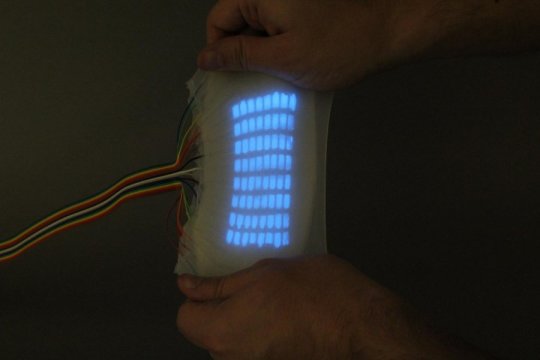
Engineers have developed an electroluminescent "skin" that stretches to more than six times its original size while still emitting light. The discovery could lead to significant advances in health care, transportation, electronic communication and other areas.
"This material can stretch with the body of a soft robot, and that's what our group does," Shepherd said, noting that the material has two key properties: "It allows robots to change their color, and it also allows displays to change their shape."
This hyper-elastic light-emitting capacitor (HLEC) can endure more than twice the strain of previously tested stretchable displays. It consists of layers of transparent hydrogel electrodes sandwiching an insulating elastomer sheet. The elastomer changes luminance and capacitance (the ability to store an electrical charge) when stretched, rolled and otherwise deformed.
"We can take these pixels that change color and put them on these robots, and now we have the ability to change their color," Shepherd said. "Why is that important? For one thing, when robots become more and more a part of our lives, the ability for them to have emotional connection with us will be important. So to be able to change their color in response to mood or the tone of the room we believe is going to be important for human-robot interactions."
In addition to its ability to emit light under a strain of greater than 480 percent its original size, the group's HLEC was shown to be capable of being integrated into a soft robotic system. Three six-layer HLEC panels were bound together to form a crawling soft robot, with the top four layers making up the light-up skin and the bottom two the pneumatic actuators.
The chambers were alternately inflated and deflated, with the resulting curvature creating an undulating, "walking" motion.

 Previous page
Previous page Back to top
Back to top







